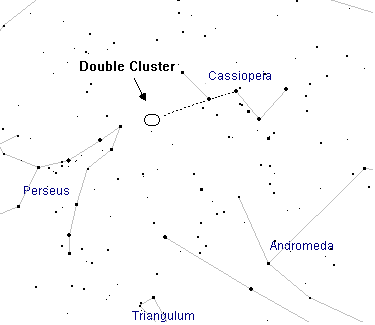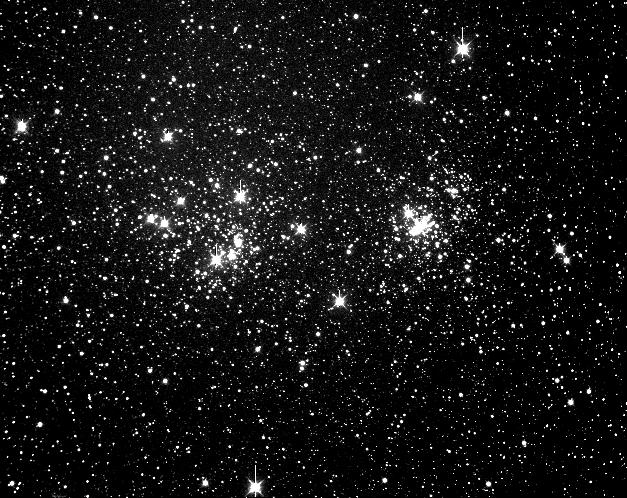The Good Ol' Double Cluster
Jack Kramer
They're so famous and so well-observed that when we mention NGC 869 and NGC 884 in Perseus by their common name -- the Double Cluster -- almost everyone knows exactly the object(s) to which we're referring. Add to this the fact that these two rich and beautiful open clusters are a snap to locate, and it's easy to see why they're included in the rounds of just about every fall and winter star party. The top photo shows the stars of Cassiopeia. Many astronomers use the stars g (27) and d (37) Cassiopeia to roughly point to the Double Cluster, as shown below. Of course, in a dark sky, you don't need any help...the cluster is a naked eye object. Even with some light pollution, it's generally visible in a finder scope, and it's well-placed in the generally darker northern sky (from Lake County).


In the large-scale photo, NGC 869 is the cluster on the right. Although we speak of the Double Cluster, it's doubtful that the two clusters are physically related. For one thing, NGC 884 is about 7500 light years distant, while NGC 869 is at about 6500 light years. Also, 884 is somewhat older. There are similarities, however. Both are the same in actual size -- about 70 light years in diameter. In comparison to other stellar groupings, they are both among the youngest clusters known, as evidenced by the dominance of large white and blue-white stars. Nonetheless, NGC 884 contains several older red supergiant stars embedded within the cluster. Through our scopes, these stars don't actually look bright red, but rather appear with a tinge of orange. Moreover, in terms of their brightness, I would say they are of average magnitude for the cluster members, so they don't stand out markedly. The colors of stars will show up better in larger aperture telescopes, thus these orange-hued stars are obvious in my 10" scope, but not in my 4". They are about the same size and luminosity as Betelgeuse in Orion. Of course, Betelgeuse is much brighter because it's only a little over 500 light years away. The stars of the Double Cluster are also believed to appear slightly dimmed because of intervening dust clouds in space.
You'll need a telescope/eyepiece combination with at least a 1o field in order to take in both clusters at the same time, but it's also worth examining each one individually using higher magnification. As with all open clusters though, they lose a lot if you over-power them. An easy way to tell which cluster is which is to look for the orange-colored stars that appear in NGC 884.
Within NGC 869 is a small grouping of five stars arrayed in a "U" shape. The shape of these stars has earned them the nickname "The False Teeth"...and this little asterism does resemble a pair of shining choppers! They're not visible in the detailed photo here due to being obliterated by the burned-in images of the brighter stars deep in the center of the cluster. One of the five stars is fainter than the rest, so in a smaller scope (e.g.: 4") there will appear to be only four stars and the "False Teeth" won't be quite so apparent.
One puzzling aspect is why Charles Messier never included the Double Cluster in his list, especially considering some of the other relatively insignificant objects he chose to record. Perhaps he concluded that it would be impossible to mistake the good ol' Double Cluster for a comet. Well yeah, I guess it would be pretty hard to mistake it for a comet!
Published in the November 1997 issue of the NightTimes




